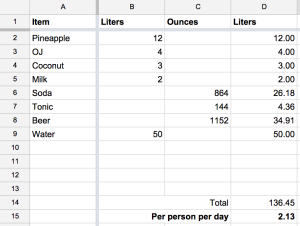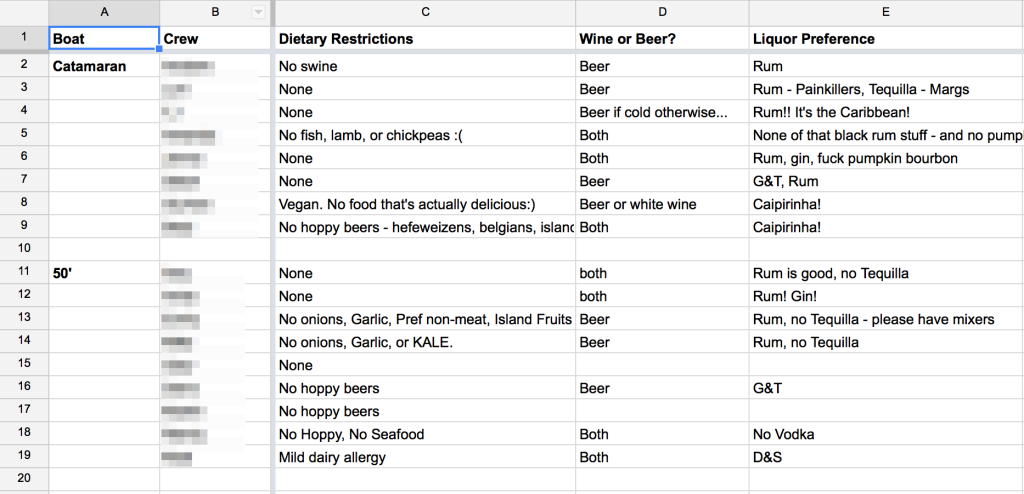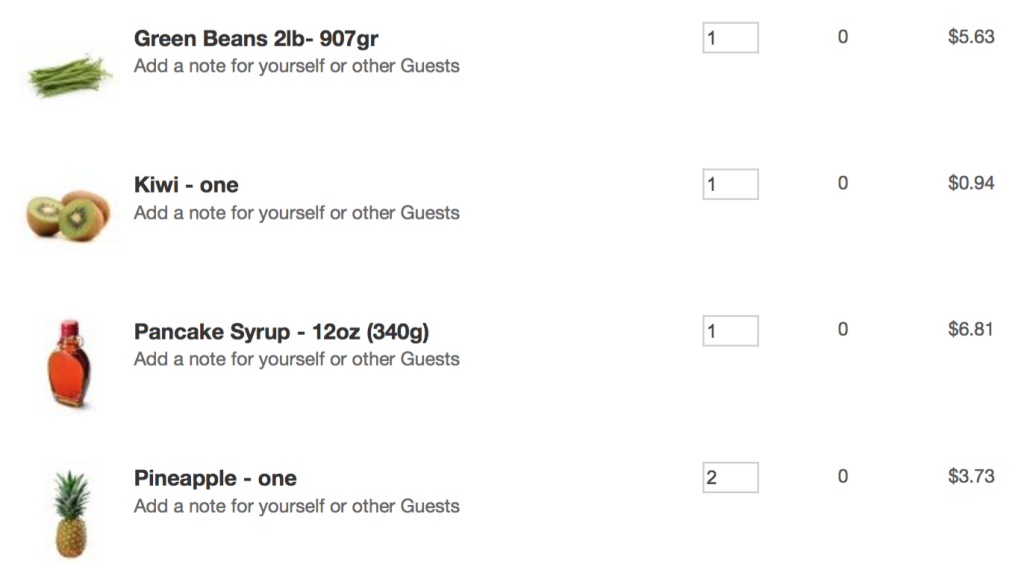Provisioning can quickly become the most involved part of planning a stay aboard a sailboat. It makes sense for one person to coordinate provisioning but it’s tough to plan meals that will suit an entire crew’s dietary restrictions let alone please their palate. Usually when you’re bareboat chartering you’re provisioning from stores that don’t have the ingredients you’re used to in an unfamiliar area (making it difficult to search from store to store…). This article is about the provisioning considerations required for bareboat chartering.
I’ll focus on the coordination and quantity selection using my most recent Antigua bareboat as an example. This was a bareboat charter with 17 people for 8 days, some of whose dietary restrictions I was unfamiliar with. I was provisioning one boat with 8 people online in advance.
Unconditional Water!
Water is the most important and least complicated thing to provision. Nobody is allergic to water. Nobody has a water intolerance. Everyone needs it; especially in the tropics!
The high end of conventional wisdom about water consumption is that you need to provision enough water for two liters per person per day. In temperate Rhode Island I’ve found that using two liters per person per day for liveaboard courses provisioning 2 liters per person per day we wrap up with water leftover. But when we chartered in Belize we knew we would have to go far out of our way to get additional water. When it’s that hot and that remote we went up to 3 liters per person per day and didn’t regret it. During that trip we consumed more than 2 liters per person per day but the 3rd liter meant we didn’t have to make a provisioning detour.

Water bottles are great to have along; make sure your crew bring their own re-fillable water bottles. That guarantees your crew has a “cup” aboard that’s easy to identify; a glass they can take it ashore and refill with water. If your crew bring 1 liter bottles you can keep an eye on their water consumption; they should be getting at least one liter of water per day.
Make sure you research the quality of water sources before suggestion refills ashore and don’t use the water from the marina hoses unless instructed (I learned that lesson when I needed two caribs to cleanse my mouth after one gulp of foul marina hose water).
Dietary Restrictions
Lots of dietary restrictions complicate provisioning. They really throw provisioning off if you only find out about them after you’ve done most of the provisioning already. So get people’s preferences early in the process to save yourself tons of time later.
For collaborative stuff like this I love google spreadsheets; everyone can fill in their own information and it’s instantly available to you. The trick is getting everyone to sign up. I like to mix encouragement, humor and threats. Especially humorous threats:
With everything going on between now and then it’s hard to believe that Antigua is only 6 weeks away! Who else is amped!?!
First, please list your dietary restrictions here: spreadsheets.google.com link . if you have dietary restrictions please pay special attention to this provisioning thread. If you don’t have dietary restrictions please check out the spreadsheet and fill in “None”; trust me you want to check out the spreadsheet otherwise I’m picking for you and I’m picking pumpkin bourbon.
Second, I volunteered to coordinate provisioning on the cat. I will need a counterpart on the 50; I’ll coach you through most of the work so the only requirement is some interest and promptly replying to emails. Let me know if you’d like to help.
See you all in the Caribbean!
That got everyone to provide their dietary restrictions. The spreadsheet was very simple and looked like this:

The next step was tallying up meals.
Meal Counts
The maximum number of meals is 3 (breakfast, lunch and dinner) x # of days x # of people. For Antigua that’s 8 days x 8 people = 64 of each meal, 64 x 3 = 192 meals would be the maximum number of meals. Then you subtract based on the habits of your party.
For breakfast we like to get underway early. 8 people won’t usually be up and going at the same time and since only 2 are required to get the boat moving in the morning breakfast that can be eaten underway by the other 6 is preferred. If you cook early in the morning in the Caribbean the cabin is going to be hotter than necessary for the rest of the day. Given all of this we decided on mostly cereal and muesli with yogurt (milk is much more spill prone). In our experience dry cereal has a tendency to get blown right out of one’s bowl as well. We included one day of eggs for breakfast and 6 more of cereal. We figured we’d grab something ashore at least one morning of the trip so that would be the 8th meal.
We also figured lunch would often be underway and better without requiring cooking. Lunch would be more likely to be further out to sea where the seas would be larger and therefore the crew would be more prone to seasickness, especially preparing food below. Eating below in any kind of seas, for some, was also out of the question. So easy to prep meals that can easily be eaten on deck were again in order. For lunch we planned 8 days of assorted build your own sandwiches. When buying the assorted sandwich makings we have to keep dietary restrictions in mind so vegan options are necessary.
We figured on 4 dinners aboard. We do like to eat ashore when we can but we didn’t expect we’d have that option for at least half the days. We prefer to grill when possible so we picked 3 grill centric meals. The other advantage of grilling is that galley space is limited so if the grill and galley are both in use the cooking effort can be divided and the meal prepared more quickly.
The cruising guides are very helpful when you plan meals; they’ll inform you about your dining and re-provisioning options at the places you plan to stop.
To snack or not to snack
If you’re sailing during daylight hours often times you arrive at your destination between lunch and dinner. In these cases you’re almost always racing the sunset if you want to explore ashore while it’s light. We always pack a daily snack that we break out as soon as we’re tied up for the day. Something simple that we can enjoy together and substantial enough that it allows us to hold off on dinner giving us more time ashore. A snack that compliments a drink celebrating a successful arrival. It’s also often the first time that everyone aboard can relax at the same time so we usually plan something that can be shared with the group off of a platter. I plan a post arrival snack every day.
Leftover Meal/Day
When provisioning for an extended period of time we allow for a Leftover Day or Leftover Meal between 5-10% of our meals. A bit of creativity and a leftover meal or day usually helps us eliminate a lot of waste from longer trips.
Meals
What you like to eat has tons of variety. There are, however, some considerations that you should take into account when you pick meals. I go into specifics above for our trip to Antigua above when I considered the day’s meals. More generally these considerations are:
- Can a meal be eaten on deck under way?
- Must this meal be prepared below? Can it use the grill and the galley?
- How long does it take to prepare a meal?
- Is this a difficult meal to prepare underway given the expected sea state?
- Is a meal best eaten simultaneously or can some eat while others handle the boat?
- Will this meal heat up the cabin? Do we want the cabin warmer?
- Will this meal heat up the crew? Would they want to be warmer?
Some meals that we often include in our provisioning are:
“Scurvy prevention”
A friend got this started when he brought aboard a bunch of fresh oranges and shared them with everyone. Basically this is any fresh fruit brought on deck to share amongst the crew between breakfast and lunch or sometime after lunch before arrival. It’s usually fresh handheld fruit and it always goes over really well. One person preps a bunch of fruit (washes grapes, peels oranges, slices up apples) and they’re shared with the crew. These are especially popular on hot days but even when it’s cold I always find this meal very refreshing; usually taking it with a fair amount of water.
Après-sail snack platter
Usually we have some grain (crackers, wheat thins, bits of pita, etc) with cheese and things for dipping (hummus, guacamole) on a shared platter shortly after we get tied up. I’ve already sung this snack’s praises in this article; it’s also a great time to discuss shorebound plans since there are more crew than there are ways to get ashore. It’s nice to sit down as a group after a successful day’s sail; it is a very social meal for the crew.
Sandwiches
Handheld to eat on deck underway, easy to prep and easy to vary given different crew restrictions and tastes make sandwiches one of my go-to meals for lunches. They also don’t usually require cooking so they keep the cabin and the chef cool.
Salty snacks
When you’re on deck exposed to the cool sea wind you often don’t realize how much you’re sweating because it evaporates so quickly. For many people this manifests as a craving for salty foods; you lose a lot of sodium as well as water when you sweat. We try to keep chips and pretzels aboard; I also find that I crave soda more aboard probably given it’s high salt content.
Loading up
Once you’ve picked the meals you combine that with the numbers for how many of each meal you want. Going from meals to ingredients is meal dependent and if you’ve bought according to your tastes you’ve got more experience getting the ingredients for the meal than I have. I often err on the side of a little to much of a given ingredient than to little and let “leftover day” handle the overflow.

Besides food, there are a lot of items that are considered provisioning; this checklist should help keep you from forgetting them. And of course there is personal and boat gear that you’re bringing that you need to remember: this checklist will help you remember everything you need.
Updated 01-Dec-2019
Leave a Reply